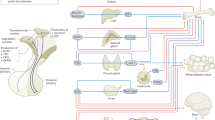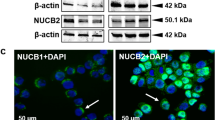Abstract
THREE structurally identified hypothalamic-adenohypophy-seal regulatory peptides—thyrotropin-releasing hormone (TRH)1,2 luteinising hormone releasing hormone (LH–RH)3,4 and growth hormone-release inhibiting hormone (somato statin or SRIF)5 have now been localised both in extra-hypothalamic regions of the central nervous system (CNS)6–9 and in certain extraneural regions such as the pineal gland10. There is increasing evidence that these peptides may affect behaviour by direct action on the brain. Systemic admini stration of TRH to rats induces behavioural effects inde pendent of the pituitary–thyroid axis11; LH–RH can induce mating behaviour in hypophysectomised female rats12 and somatostatin potentiates the behavioural effects of d 1-dopa13. These findings together with evidence of high affinity binding sites for TRH in extrahypothalamic tissues14 identification of LH–RH in synaptosome fractions of brain15 and localisation of LH-RH16,17 and somatostatin18,19 in nerve terminals suggest a role for these peptides in neuronal function. Applying TRH, LH–RH and somatostatin directly to central neurones microiontophoretioally we have found that these peptides have a potent depressant action on the activity of neurones at several levels (cerebral and cerebellar cortex brain stem and hypothalamus) of the neural axis.
This is a preview of subscription content, access via your institution
Access options
Subscribe to this journal
Receive 51 print issues and online access
$199.00 per year
only $3.90 per issue
Buy this article
- Purchase on Springer Link
- Instant access to full article PDF
Prices may be subject to local taxes which are calculated during checkout
Similar content being viewed by others
References
Nair, R. M. G., Barrett, J. F., Bowers, C. Y., and Schally, A. V., Biochemistry, 9, 1103–1106 (1970).
Burgus, R., Dunn, T. F., Desiderio, D., Ward, D. N., Vale, W., and Guillemin, R., Nature, 226, 321–325 (1970).
Schally, A. V., et al., Biochem. biophys. Res. Commun., 43, 393–399 (1971).
Amoss, M., Burgus, R., Blackwell, R., Vale, W., Fellows, R., and Guillemin, R., Biochem. biophys. Res. Commun., 44, 205–210 (1971).
Brazeau, P., et al., Science, 179, 77–79 (1973).
Jackson, I., and Reichlin, S., Endocrinology, 95, 854–862 (1974).
Arimura, A., Schally, A. V., in Proc. Int. Hypothalamic Hormone Conf., Milan, October 1974 (Exerpta Medica, Amsterdam, in the press).
White, W. F., and Wilber, J. F., in Proc. Int. Hypothalamic Hormone Conf., Milan, October 1974 (Exerpta Medica, Amsterdam, in the press).
Patel, N., Weir, E. C., and Reichlin, S., Abstr. 57th Ann. Meeting Endocr. Soc. (in the press, 1975).
White, W. F., et al., Endocrinology, 94, 1422–1426 (1974).
Prange, A. J., Jr, The thyroid axis, drugs and behavior (Raven Press, New York, 1974).
Moss, R. L., and McCann, S. M., Science, 181, 177–179 (1973).
Plotnikoff, N. P., Kastin, A. J., and Schally, A. V., Pharmac. Biochem. Behav., 2, 693–696 (1974).
Burt, R. D., and Snyder, S. H., Abstr. 101, Proc. Soc. Neurosci., fourth Ann. Meeting, St. Louis (1974).
Ramirez, R., and Kordon, C., in Proc. Int. Hypothalamic Hormone Conf., Milan, October 1974 (Exerpta Medica, Amsterdam, in the press).
Zimmerman, E. A., Hsu, K. C., Ferin, M., and Kozlowski, G. P., Endocrinology, 95, 1–11 (1974).
Pelletier, G., Labrie, F., Puviani, R., Arimura, A., and Schally, A. V., Endocrinology, 9, 314–318 (1974).
Pelletier, G., Labrie, F., Arimura, A., and Schally, A. V., Am. J. Anat., 144, 445–450 (1974).
Hökfelt, T., Effendic, S., Johnansson, O., Luft, R., and Arimura, A., Brain Res., 80, 165–169 (1974).
Renaud, L. P., Brain Res., (in the press).
Renaud, L. P., and Martin, J. B., Brain Res., 86, 150–154 (1975).
Dyer, R. G., and Dyball, R. E. J., Nature, 252, 486–488 (1974).
Kawakami, M., and Sakuma, Y., Neuroendocrinology, 15, 290–307 (1974).
Krnjević, K., and Morris, M. E., Can. J. Physiol. Pharmac., 52, 736–744 (1974).
Nicoll, R. A., and Barker, J. L., Nature new Biol., 233, 172–174 (1971).
Renaud, L. P., and Martin, J. B., Brain Res. (in the press).
Nicoll, R. A., and Barker, J. L., Brain Res., 35, 501–511 (1971).
Author information
Authors and Affiliations
Rights and permissions
About this article
Cite this article
RENAUD, L., MARTIN, J. & BRAZEAU, P. Depressant action of TRH, LH-RH and somatostatin on activity of central neurones. Nature 255, 233–235 (1975). https://doi.org/10.1038/255233a0
Received:
Issue Date:
DOI: https://doi.org/10.1038/255233a0
Comments
By submitting a comment you agree to abide by our Terms and Community Guidelines. If you find something abusive or that does not comply with our terms or guidelines please flag it as inappropriate.



